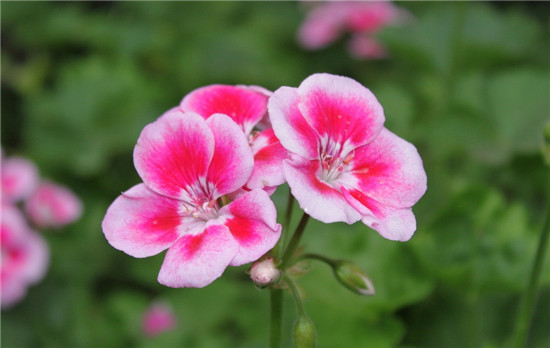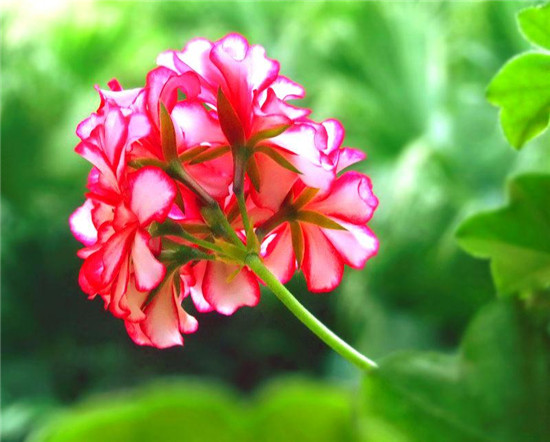Culture methods of geraniums Culture skills of geraniums
Geranium, also known as hydrangea, hydrangea, is native to southern Africa and is widely cultivated all over the world. Next, let's take a look at the culture methods and techniques of geraniums.

Geranium, also known as hydrangea, paraffin red, etc., is a perennial herb of the Bovine Seedling family. The flowering period is long, except when the summer weather is hot, it can blossom from October to the following spring from April to May. The flowers are colorful and varied. It is a good potted flower. It likes warm climate and fertile loose soil, resistant to drought and waterlogging, poor growth in hot summer and high temperature, and is in a semi-dormant state.
Potted geranium, the basin soil can be mixed with rotten leaf soil mixed with appropriate amount of sand and rice bran ash as soil, plus a small amount of bone powder. The pot should be changed once a year and the new culture soil should be replaced to facilitate growth and flowering. The basin change should be carried out from mid-August to early September. Before changing the basin, the plant should be trimmed and shaped, and the basin should be changed after the basin soil and cut are dry. When changing, trim some longer and excessive fibrous roots appropriately. Put it in the sunny place with good ventilation in the middle and late April every year for maintenance.

In order to make it blossom continuously, the fertilizer and water of thin mature cake should be applied frequently, and it is appropriate to apply it every 10 days. You don't need to water too much at ordinary times. Otherwise, it will cause leaves to turn yellow, plant growth is poor, can not form a robust bud. Watering, generally should be in the leaf tip wilting re-watering, watering must be thoroughly. From late June to early August, the climate is hot and pelargonium is in a semi-dormant state. Fertilization should be stopped and watering should be controlled.
High temperature, direct sunlight and stagnant water in the basin after rain will affect the dormancy of geraniums and even the death of rotten roots. Therefore, the dormant period should be put on the shady balcony, windowsill, or the courtyard to avoid the light and not be drenched by rain. This can also reduce dormancy time.
Soil selection of Pelargonium Culture
The pelargonium pot culture soil can be mixed with 4 humus soil, 3 garden soil (or peat soil), 2 river sand (or perlite) and 1 organic fertilizer, or mixed with fine sand soil, humus soil, perlite and organic fertilizer. Potted geraniums need to be turned in autumn.

Fertilization methods for culture of geranium
During the growth period, liquid fertilizer is applied every 10-15 days, while in the vigorous spring and autumn seasons, liquid fertilizer is applied every 7-10 days; nitrogen fertilizer is the main fertilizer before budding, and phosphorus and potassium fertilizer is the main fertilizer after budding, and the concentration is 0.1%. 0.2%. If the room temperature is relatively high in winter and does not stop growing, it should also be fertilized. Fertilization should be stopped when the plant is semi-dormant during the period of high temperature in summer. Because its stems and leaves are pilose, rinse with clean water immediately after fertilization.
Watering method of geranium culture
Watering properly would rather be dry than wet. Spring and autumn growth season should meet sufficient moisture, so that the basin soil often keep moist, but not stagnant water; in low temperature cloudy days, generally do not water, do not fertilize; less watering in summer. The high temperature season in the north is in the rainy season, during which the root system of the plant is relatively weak, so too much Rain Water irrigation should be avoided; days of overcast and rain will cause root rot, which should be placed in a place to avoid shade, dryness and ventilation. It can be watered according to the indoor temperature in winter, less watering at low room temperature and more watering at high room temperature. Pelargonium has a strong ability to withstand drought and will not die without watering for a few days, but the old leaves will turn yellow and fall off.
Watering should see dry and wet, basin soil is too wet and easy to rot roots, basin soil is too dry is easy to cause leaves withered and yellow, semi-dormant state from June to July, watering should be strictly controlled. In summer, we often spray water to cool down, keep the basin soil moist, and pay attention to ventilation and light transmission. Control watering in winter.

Temperature requirements for geranium culture
Geraniums like warmth, avoid high temperature, and fear cold. The suitable temperature for the growth of geranium is 15-25 ℃, and the indoor temperature should be kept at 10 ℃ in winter. Less than 3 ℃ is susceptible to chilling injury, but some varieties can tolerate the low temperature of 0 ℃. In summer, when the temperature exceeds 35 ℃, it enters a semi-dormant state.
Light requirements of geranium culture
It grows strongly under direct sunlight, the leaves are dark green, the internodes are short, and the plant shape is beautiful. But when the summer light is too strong, 30% shade is needed. 50%. When raising families, they should be placed in places with direct sunlight in autumn, winter and spring, and can be moved indoors to enjoy them when they are in bloom, but they should still be placed in a place with light after flowering. Like sufficient sunshine, lack of light, do not blossom; flowering should avoid direct strong light, otherwise, petals scorched, easy to wither.
Turn the basin once a week to make the leaf surface receive light evenly. Keep the plant shape symmetrical. Keep it in the shade in summer to avoid the hot sun. The room temperature in winter is not less than 5 ℃, and the light is fully visible.
The above is the whole content of the geranium culture methods and techniques I summarized for you. I hope this article can help you. Please continue to follow us.
Keep the plant shape symmetrical. Keep it in the shade in summer to avoid the hot sun. The room temperature in winter is not less than 5 ℃, and the light is fully visible.
The above is the whole content of the geranium culture methods and techniques I summarized for you. I hope this article can help you. Please continue to follow us.
- Prev

The difference between Scutellaria barbata and Hedyotis diffusa the characteristics of Scutellaria barbata and Hedyotis diffusa
The difference between Scutellaria barbata and Hedyotis diffusa the characteristics of Scutellaria barbata and Hedyotis diffusa
- Next

Technical points of potted flowers in winter
Technical points of potted flowers in winter
Related
- Wuhan Hospital Iron Tree Blooming Result Was Instantly Frightened by the Gardener Master
- Which variety of camellia is the most fragrant and best? Which one do you like best?
- What is the small blue coat, the breeding methods and matters needing attention of the succulent plant
- Dormancy time and maintenance management of succulent plants during dormancy
- Minas succulent how to raise, Minas succulent plant pictures
- What are the varieties of winter succulent plants
- How to raise succulent plants in twelve rolls? let's take a look at some experience of breeding twelve rolls.
- Attention should be paid to water control for succulent plants during dormant period (winter and summer)
- Watering experience of twelve rolls of succulent plants
- Techniques for fertilizing succulent plants. An article will let you know how to fertilize succulent plants.

